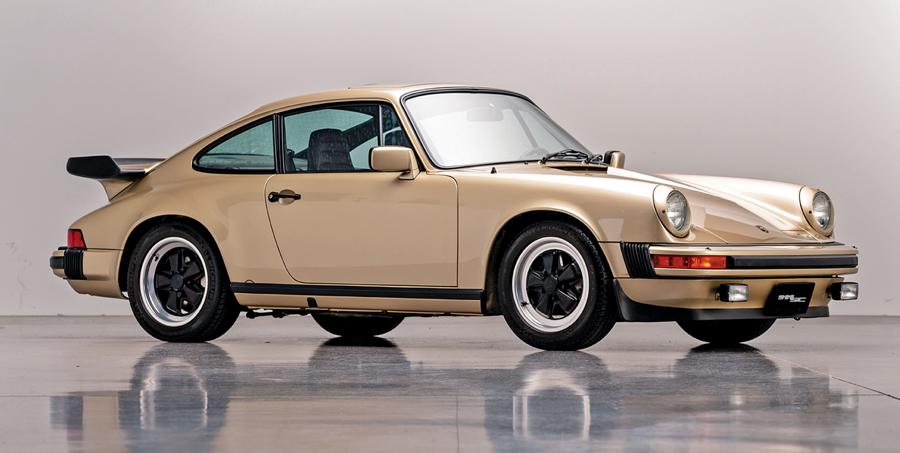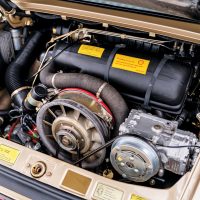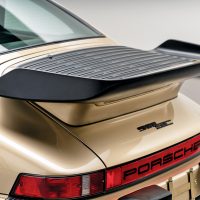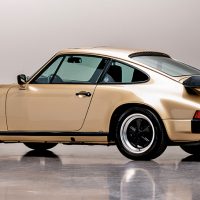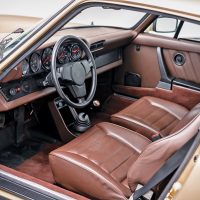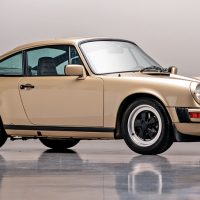- Exceptional preserved example; less than 8,350 miles from new
- Well-equipped with desirable factory options. Has factory books and original sale paperwork
- Includes window sticker and service receipts from new
SCM Analysis
Detailing
| Vehicle: | 1983 Porsche 911SC |
| Years Produced: | 1978–83 |
| Number Produced: | 1983: 5,699 coupes |
| Original List Price: | $30,270 coupe, before options |
| SCM Valuation: | $45,000 |
| Tune Up Cost: | $1,000 with valve adjustment |
| Chassis Number Location: | Stamping above gas tank, tag at bottom of driver’s side windshield |
| Engine Number Location: | Vertical fan support, passenger’s side, facing right |
| Club Info: | Porsche Club of America |
| Website: | http://www.pca.org |
| Alternatives: | 1983 Ferrari 308 GTBi, 1983–86 Porsche 928 S, 1979–83 Datsun 280ZX Turbo, 1982–88 Lamborghini Jalpa |
| Investment Grade: | B |
This car, Lot 27, sold for $81,200, including buyer’s premium, at Gooding & Company’s Amelia Island, FL, auction on March 8, 2019.
Porsche 911s built from 1974 through 1989 inspire loyalty among their owners — and ennui among other people.
The new 1974 cars were not instantly accepted. The cars combined Bosch K-Jetronic “continuous injection systems” (CIS) with milder camshafts and lower redlines. Traditionalists preferred the more raucous, charismatic — but highly polluting — mechanical-fuel-injection cars of 1969–73.
Nonetheless, Porsche engineered very comparable performance into the new cars, in part because of better torque from the extra 300-cc engine displacement, up to 2.7 liters.
Porschephiles disliked elements of the new model
Mechanics needed time to learn to work on the CIS systems, which required no vacuum leaks. It did not help that cold starts and heat-soak restarting were difficult — or that backfires occasionally blew up airboxes and started engine fires. The high back seats with built-in headrests looked similar to VW seats. And almost everyone considered the bulky shock-absorbing 5-mph impact bumpers mandated by the U.S. government to be ugly.
The oil crisis, resultant lower speed limits in America and Germany — and higher Porsche prices in the U.S. as the Deutschmark gained over the dollar — also combined to hurt sales. The production of 911s in 1974 fell 36% from 1973.
Porsche kept the G-body styling for 16 years, with modest changes to tails, bumpers and side contours that even cognoscenti couldn’t recite. From 1949 to 1965, Porsche’s first 16 years, 356s underwent five substantial styling updates. Long-hood, aka low-bumper, 911s lasted just 10 years from 1964 to 1973, with one bodywork update to accommodate 1969’s 2.4-inch-longer wheelbase.
The 911 was presumed to be dead
In the early 1980s, Porsche executives had anticipated the demise of the 911 as governments promulgated pollution and car-safety requirements. Porsche was hugely relieved when their engineering push created EPA/DoT-compliant cars — and then improved them. In 1974, Ferry Porsche announced that he foresaw the 911 living until 1980.
That kill-by date was extended and then canceled as the “pretender” replacement models all developed clay feet — the 928 foremost among them. Porsche’s engineers probably never bought into killing the 911, but customers provided the bigger impetus.
Porsche’s water-cooled, front-engined cars — the 928 and the 924/944/968 — never challenged the 911’s popularity.
Peter Schutz helped save the 911
The 1981 alliance between Chief Engineer Helmut Bott and new Porsche AG President Peter Schutz guaranteed the 911’s long-term future, abetted by Ferry Porsche’s strong endorsement. (Schutz was German-American. He was born in Berlin in 1930, and his family migrated to the U.S. in 1941.)
Although Schutz’s American management style was not well received inside hierarchical Porsche, Schutz did three things that endeared him to all:
He ordered that Porsche return to Le Mans with the victorious 936s.
With the 1983 911SC, he brought back cabriolets, which had disappeared with the last 356 in 1965.
And he killed any plans that a front-engined, water-cooled Porsche would replace the 911.
The 1974–89 911s are suddenly nostalgic
All that explained, looking back from today, the 1974–89 cars have become nostalgic. They are also somewhat attractive. They’re mechanically bulletproof from about 1980 up — if you ignore little oil leaks. Most of all, they have the old-school driving characteristics beloved by the “hang out the tail” crowd.
When it was introduced in 1978, the SC brought back some enthusiasts who left the reservation in 1974 at the beginning of the impact-bumper era. The big attraction was a new 3.0-liter engine derived from the recently introduced Turbo powerplant.
There were issues with weak exhaust-valve springs, failures of the “doughnut” rubber-center clutch plate, and airboxes that occasionally still blew up (aftermarket pop-off valves were the only sure solution), but the cars gained broader acceptance.
The return of the aluminum case
The 1977-and-earlier 2.7-liter magnesium cases had never been strong. Cylinder barrel studs pulled out, cases warped, and oil leaks sprung up — a lot of it promulgated by higher heat caused by 1974’s EPA strictures that led to running lean (in order to burn clean) and the addition of thermal reactors. Also, the maximum cylinder-stud spacing provided up to only 2.9 liters of displacement. The new aluminum-case 3.0-liter Type 930/02-plus normally aspirated engines solved those problems.
The 1974–77 911s had two bodies — the slab-sided 911 and 911S with six-inch wheels all around — and the Carrera body with wider rear hips over seven-inch rear wheels. The SC killed the slab-sided bodywork.
A steady road back to financial health
Porsche 911 production peaked in 1973 at 15,415 units, and then went into a tailspin with 9,909 cars in 1974 and 7,913 cars in 1975. Thereafter, volume built slowly with a few wiggles back to the 15,000 level by 1986, excluding Turbos, which averaged about 1,600 per year for 1976–89.
Our subject 911SC
Our subject car was one of 49 cars being sold by a notable Midwest collector of Porsches and Ferraris.
Gooding sold about half of his cars in Monterey last August and the remainder at Amelia Island.
This collector, also my good friend, was thinning his herd. An avid car guy, he had purchased a lot of cars over 20 years that appealed to him at the time. Later, his tastes and preferences changed. The 49 cars he sold off were not integral to his collection, and they took up a lot of room.
I remember when he enthusiastically purchased our subject SC from Michael Willhoit, who had obtained it from its original Arizona owner.
Although just a plain-Jane production-model SC, it was a nice one. It had about 8,000 miles in an attractive period color, Light Bronze Metallic — and it was very original. As you know, I have a soft spot for original-paint cars. If the paint is excellent original, you know all the metal is not wrecked or rust-repaired.
The 911SC at auction had just two prior owners. It had all its paperwork, including the original window sticker and service records. It was nicely optioned with rear wing and front splitter, limited slip, full leather, and the funky Blaupunkt Monterey radio.
This 911SC was well bought
An 80,000-mile 911SC is a $40,000 driver. An 8,000-mile, all-original example is an entry-level collectible for light driving and car shows — if that’s your bent.
This car sold for $81,200, perhaps surprising to some. Not to me. The car checked a lot of boxes. For $10,000 less, I would have been taking it home — probably should have anyway. Drats. Looking back, I think it was well bought. ♦
(Introductory description courtesy of Gooding & Company.)
